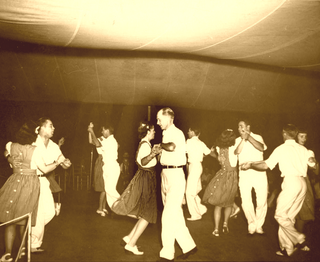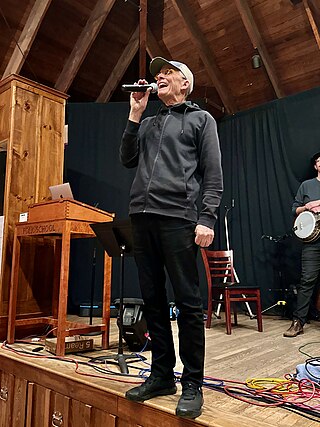
Contra dance is a form of folk dancing made up of long lines of couples. It has mixed origins from English country dance, Scottish country dance, and French dance styles in the 17th century. Sometimes described as New England folk dance or Appalachian folk dance, contra dances can be found around the world, but are most common in the United States, Canada, and other Anglophone countries.

A square dance is a dance for four couples, or eight dancers in total, arranged in a square, with one couple on each side, facing the middle of the square. Square dances are part of a broad spectrum of dances known by various names: country dances, traditional dances, folk dances, barn dances, ceilidh dances, contra dances, Playford dances, etc. These dances appear in over 100 different formations, of which the Square and the Longways Set are by far the most popular formations.

Modern western square dance is one of two American types of square dancing, along with traditional square dance. As a dance form, modern western square dance grew out of traditional square dance in the American West. The term western square dance, for some, is synonymous with "cowboy dance" or traditional western square dance. Therefore, this article uses the term "modern western square dance" to describe the contemporary non-historical dance which grew out of the traditional dance. Modern western square dance was the official dance of the United States from 1982 to 1993.
Square dance clubs are the primary form for organization within the recreational activity of square dancing, and more specifically modern western square dance. This article's focus is the modern western square dance club, and it is understood in the context of this article that when the terms "square dance club" or "square dance" are used it refers to the form of square dance called "modern western square dance".

Guy Lewis Steele Jr. is an American computer scientist who has played an important role in designing and documenting several computer programming languages and technical standards.

Rubik's Magic, like the Rubik's Cube, is a mechanical puzzle invented by Ernő Rubik and first manufactured by Matchbox in the mid-1980s.

A caller is a person who prompts dance figures in such dances as line dance, square dance, and contra dance. The caller might be one of the participating dancers, though in modern country dance this is rare.

The American Callers Association (ACA) is the second largest association of square dance callers in the United States. ACA is a non-profit organization with headquarters at Muscle Shoals, Alabama. ACA has members in the United States, Canada, Europe, and New Zealand.
Alliance of Round, Traditional and Square-Dance, Inc. (ARTS-Dance) is an association to promote round, square, line, and other forms of traditional and folk dance. It is a non-profit/charitable foundation under the U.S. Internal Revenue Service section 501(c)(3) incorporated in North Carolina in 2003 with main address in San Diego, California. It used to be known as ARTS Alliance.
Lloyd Shaw (1890-1958), also known as Dr. Lloyd "Pappy" Shaw, was an educator, and is generally credited with bringing about the broad revival of square dancing in America. He was superintendent, principal, teacher, and coach for Cheyenne Mountain Schools in Colorado Springs, Colorado from 1916-1951, and taught folk dancing.
Do-si-do is a dance move in squaredancing where two partner, standing next to each other and both facing opposite directions, clasp arms together and go in a circle.
Youth square dancing is square dancing among people up to their mid-twenties. In specific contexts, e.g., in qualification for some event, it may refer to dancers up to a particular age such as 18. It also may refer to a style of dancing that, while most popular among younger dancers, can be enjoyed by some older dancers.
Promenade is a basic dance move in a number of dances such as English Country Dance, contra dance, and square dance. The name comes from the French word for "walk", and is a good basic description of the dance action.
Right and left grand, also known as grand right and left, is a square dance move in which all eight dancers in the set, moving in a circular fashion, execute a series of four alternating hand pull-bys. Men travel counter-clockwise around the ring, and ladies travel clockwise. The result is that all dancers end up half way across the set facing the same person they started with.
Tech Squares is a square and round dance club at the Massachusetts Institute of Technology. It was founded in 1967 and is still holding dances today. Tech Squares dances high-energy modern Western squares in an "all position" style, with no dress code or couples requirement. It has many student members. The club dances the Plus program, but many members also dance advanced and challenge levels.
A square dance program or square dance list is a set of defined square dance calls or dance steps which are associated with a level of difficulty. Programs and program lists are managed and universally recognized in modern western square dance.
Challenge square dance, also known as Challenge dancing, is modern western square dance focused on the puzzle-solving aspects of square dancing at the most difficult or "challenging" levels.

Traditional square dance is a generic American term for any style of American square dance other than modern Western. The term can mean (1) any of the American regional styles that existed before around 1950, when modern Western style began to develop out of a blend of those regional styles, or (2) any style that has survived, or been revived, since around 1950. The term Traditional Square Dance is also used in England to refer to dances collected from villages in the first half of the 20th century.

Bob Dalsemer is a square and contra dance writer and caller. He has called dances for more than 40 years and in more than 33 states, plus internationally in Canada, the Czech Republic, Britain, Belgium, Denmark and Russia. He wrote the book West Virginia Square Dances and Folk Dance Fun for Schools and Families. He has also compiled the cassette/book compilations Smoke On the Water: Square Dance Classics and When The Work's All Done: A Square Dance Party For Beginners and Old Hands.

Ralph George Page was an American contra dance caller. He was influential in spreading it from New Hampshire to the rest of the United States and other countries, and was recognized as an authority on American folk dance overall.










